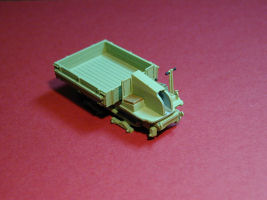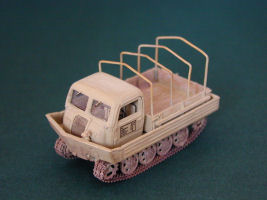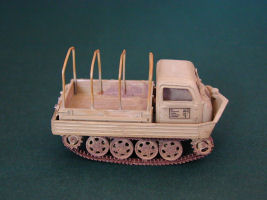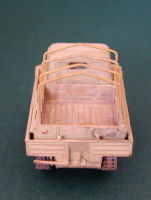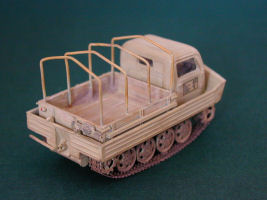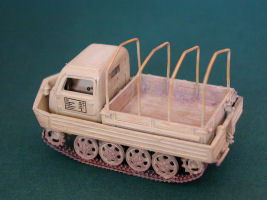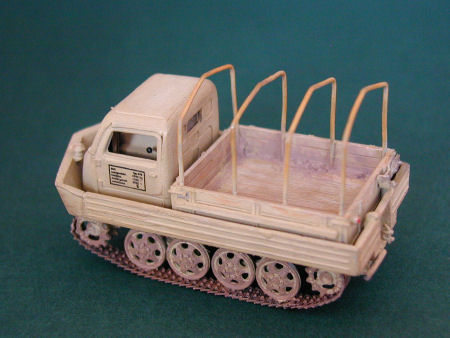
Ace 1/72 RSO/01 with Flotation Kit Build Review
By Llarry Amrose
| Date of Review | July 2011 | Manufacturer | Ace |
|---|---|---|---|
| Subject | RSO/01 with Flotation Kit | Scale | 1/72 |
| Kit Number | 72277 | Primary Media | Styrene |
| Pros | Nice detailing | Cons | Short-run, instructions vague in spots |
| Skill Level | Experienced | MSRP (USD) | $13.50 |
Build Review
With Operation Barbarossa, the invasion of the Soviet Union in 1941, the Wehrmacht discovered what transportation in Russia truly entailed. The lack of roads in many areas, together with mud and snow resulted in awful driving conditions. Clearly a new vehicle solution was needed.
Austrian manufacturer Steyr proposed a fully tracked vehicle based on their successful 1500A one-and-a-half ton truck. Called the Raupenschlepper Ost (Crawling Tractor – East), it was quickly accepted into service in mid-1942. It proved to be very effective and popular for all sorts of transport tasks on the Eastern front. Orders soon surpassed Steyr’s production capacity, and more manufacturers were lined up. Eventually 23-27,000 were made (figures vary), later models with a simplified cab design.
Unsurprisingly, many were modified for specific tasks, including ambulances and even anti-aircraft and anti-tank versions. The subject of this kit is a 1943 modification of a flotation kit consisting of a lightweight boat body for crossing small rivers.
For such an important vehicle on the Russian front, there was no injection version until ACE came along. They have produced kits of a number of versions, including early and late cabs, an ambulance, this flotation kit version, and ones carrying a 20mm AA gun or a 75mm anti-tank gun. Most of these are now out of production at ACE, but still available through on-line retailers.
Inside the attractive lightweight lid and tray box are six sprues of moderately soft light gray plastic. The first two are identical, and contain the wheels and other symmetrical parts of the suspension and cargo box. The next three complete the basic RSO kit parts. The sixth sprue contains the parts unique to this version, the flotation body and a pair of replacement doors for the cab. A sizable photo-etched brass fret contains four sections of tracks, a couple of spare links, and a pair of windshield wipers. The decal sheet has data blocks for the cab doors.
Make no mistake, this is a short-run kit, and some care will be needed in the construction. Still, “short-run” doesn’t quite mean what it used to. Gone are the crude castings, prominent ejector towers and huge sprue attachments. A few years ago I built one of ACE’s antitank guns, and there was some issue with the alignment of the two halves of the molds. I’m happy to say this kit is much better in that regard.
The instructions are the fairly usual folded page, with one page of parts diagram, two pages of construction, and one page with two paint schemes. The construction diagrams are a mixed bag, with a couple of exploded diagrams, but most of the parts shown in place. In a few places, this can make it harder to figure out exactly where certain parts are to be attached. There is no historical account or statistics, but ACE has an interesting solution. Their website ( www.acemodel.com.ua) includes almost every kit, even those currently out of production. Each page has pictures of the sprues and links to walk around photo essays of real examples on display.
Construction consists of five steps. Two of them are the cab and the cargo bed, and so can be built at any time. The other steps build up in sequence. I ended up changing the order, with mixed results. The first step is the lower body and suspension. The directions tell you to drill out the backs of the road wheels deeper so they will fit better onto the axle pins. As I mentioned earlier, the instructions are not always clear, showing some parts in place and not how to get them there. The trickiest part here is #25, the muffler and exhaust pipe. There is no indication of where the part goes, and not a single diagram anywhere from the other end showing it in place. I gave it my best guess and still ended up needing to move it.
Step two is the addition of the flotation body to the chassis. I had jumped ahead and placed the cargo bed and the floor of the cab first, which I don’t recommend. Inserting the boat hull parts afterwards is possible, but it would have been a good bit easier if done in the proper order. This step also describes folding up the photoetched tracks, even though they won’t be installed until the end. ACE recommends heat-treating them to make them more flexible. The parts are reasonably thin and flexible already, but the heat-treatment is probably worth it.
The cab comes next. This is a self-contained unit that can be worked on while waiting for glue, putty or paint to cure in other stages. This contains the smallest parts of the kit, so be careful removing them from the sprues. There are two sets of doors, so be sure to identify the correct ones. The windows are not provided, but are to be cut from thin acetate using the templates printed in the next section. I skipped the driver’s window – he’s got it rolled down. This is the one section you’ll need to paint before assembly, though it’s not all that visible through the windows. Finally, the directions tell you where to drill to accommodate the photoetched windshield wipers. They’re small, but they really look good once painted and installed.
The cargo bed is relatively simple, and there is a template to use wire to create the frames which would be present even if a canvas cargo cover was not present. Finally it all comes together and it’s time to install the tracks. Each track is made of two lengths, and if needed, there are a couple of extra links on the fret. The directions recommend removing the sprocket teeth as needed, and I found that helped a lot in terms of length and fit.
Two paint schemes, both from the infamous “Unknown Unit”. The first is from Poland in 1944 and is overall Panzer Dark Yellow with an irregular squiggle of dark green. The second is labeled as autumn 1943 in the Ukraine in plain dark yellow. Decals for data blocks on the cab doors complete the markings. I kept it simple with the second option. I ended up adding some dirt to the bed using Tamiya weathering sticks to cover a little bit of extra CA glue from installing the cargo cover frames.
These days, 72nd scale builders are livin’ the dream. We have a greater variety of kits, of both important and obscure subjects than ever before, and mostly at surprisingly affordable prices. ACE is one of the companies leading the way. The molding quality and kit design are definitely at the upper end of what we call “short-run”. There are a few pieces which the builder must fabricate, though the directions are very clear about providing templates to work from. The photo-etched tracks will be a matter of personal taste, but there’s no denying that they are a lot more in scale than plastic or vinyl tracks. I would not recommend this kit to a beginner, but anyone with some experience with short-run planes or tanks should do just fine.
My thanks to HobbyTerra for this review sample.








